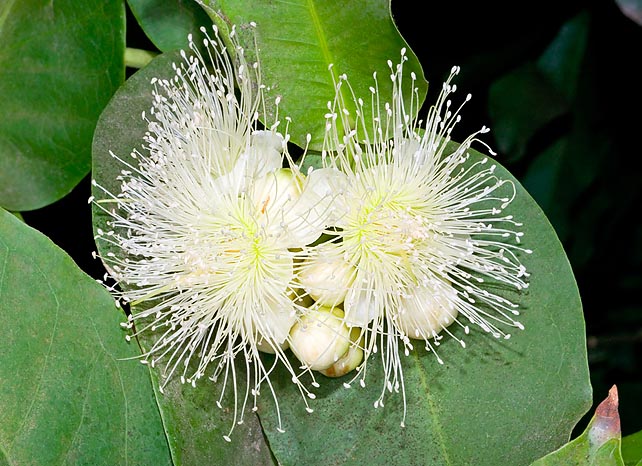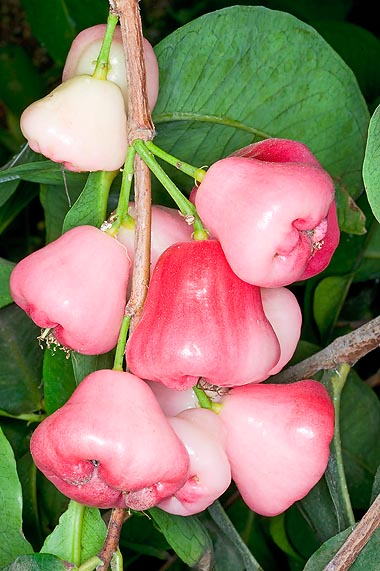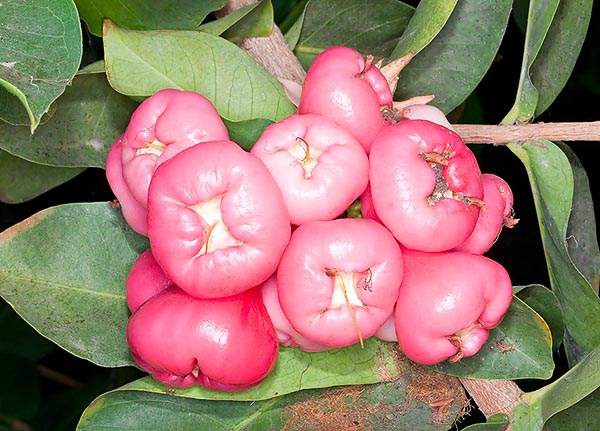Family : Myrtaceae

Text © Pietro Puccio

English translation by Mario Beltramini

The Syzygium aqueum flowers have 4 spatulate petals and long stamina © Giuseppe Mazza
The name of the genus is the combination of the Greek terms “sys” = together and “zygon” = yoke, with reference to the merged petals in some species; the Latin name of the species, “aqueum” = aqueous, refers to the pulp of the fruit.
Common names: bellfruit, water-apple, water cherry, watery rose-apple (En- glish); jambo ayer, jambosier d’eau, jam- bolanier d’eau, pomme d’eau, pomme de Java (French); mela d’acqua (Italian); jambu air, jambu ayer mawar, jambu chili, jambu penawar (Malay); jambo branco, jambo d’agua, jambeiro aguado (Portuguese Brazil); cajuilito solimán, manzana de agua, perita costeña, perita de agua, tambis (Spanish); Wasserjambuse (German).
The Syzygium aqueum (Burm.f.) Alston (1929) is an evergreen, 3-10 m tall tree, ramified until the base, with brown bark, which with the age gets fissured and peels off, and thick and irregular foliage.

The fruits are piriform or bell-shaped berries © Giuseppe Mazza
The inflorescences are axillar and terminal, on a short peduncle, carrying 3 to 7 flowers with 4 spatulate petals, about 0,7 cm long, of pale yellow or pinkish colour and several stamina, of the same colour of the petals, up to 2 cm long.
The fruits are piriform or bell-shaped berries, flattened at the two ends, 1,5-2 cm long and 2,5-3,5 cm broad, of white, pink or red, colour, with white or pinkish pulp, crunchy or spongy, aqueous (the water contents in the pulp exceeds the 90%), refreshing, with a light sweetish taste.
The fruits may be seedless or may contain 1 to 6 seeds, most frequently, 1-2. It usually reproduces by seed, which is to be placed in the soil as soon as possible, as its has a very short lasting germination capacity, in sandy and organic substratum, kept humid, at the temperature of 22-24 °C, with the first fructification happening after 3-4 years; air layering and grafting may be also utilized for conserving particular characteristics of the mother plant, such as the absence of seeds.
It is a species for tropical as well as for humid subtropical with rainfall distributed almost uniformly all over the year climate, if cultivated in seasonal climates it needs an input of water during the dry season; it does not bear temperatures close to the 0 °C for prolonged periods.
It requires an exposition in full sun or slight shade and is not particular for what the soil is concerned, being capable to grow in the sandy and light soils as well as in the heavy ones, even with water stagnation; it has a good resistance to the saltiness.
The fruits, rich of vitamin A and C and minerals, are consumed fresh, as they are or in slices in fruit salads, locally, being highly perishable or conserved in syrup or utilized for preparing drinks, ice creams and preserves.
It is often cultivated in the private gardens as ornamental plant but also for its fruits. The wood, reddish, is of good quality and is utilized for tools and handicrafts.

1,5-2 cm long and 2,5-3,5 broad, they are sweet and refreshing, rich of A and C vitamins © G. Mazza
Synonyms: Eugenia aquea Burm.f. (1768); Eugenia nodiflora Aubl. (1775); Eugenia malaccensis Lour. (1790); Myrtus obtusissima Blume (1826); Jambosa aquea (Burm.f.) DC. (1828); Jambosa obtusissima (Blume) DC. (1828); Eugenia alba Roxb. (1832); Jambosa alba (Roxb.) G.Don (1832); Malidra aquea (Burm.f.) Raf. (1838); Myrtus timorensis Zipp. ex Span. (1841); Cerocarpus aqueus (Burm.f.) Hassk. (1842); Eugenia obversa Miq. (1850); Gelpkea stipularis Blume (1850); Jambosa ambigua Blume (1850); Jambosa madagascariensis Blume (1850); Jambosa timorensis Blume (1850); Eugenia stipularis (Blume) Miq. (1855); Jambosa calophylla Miq. (1855); Eugenia callophylla (Miq.) Reinw. ex de Vriese (1856); Jambosa subsessilis Miq. (1861); Eugenia mindanaensis C.B.Rob. (1909); Syzygium obversum (Miq.) Masam. (1942).
→ To appreciate the biodiversity within MYRTACEAE family please click here.
